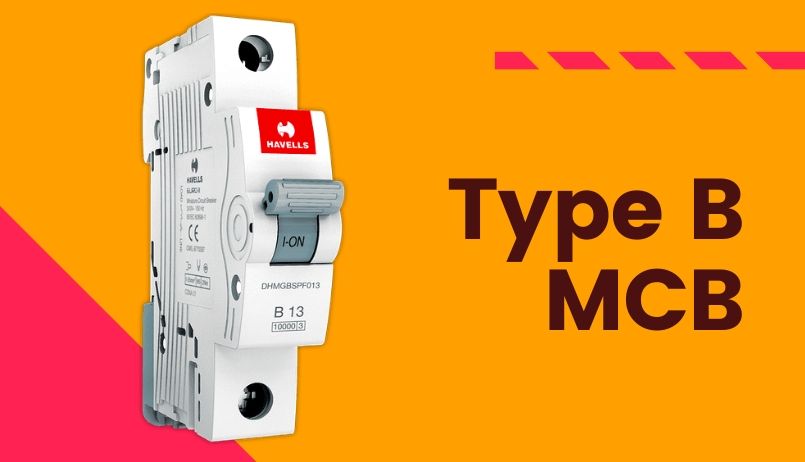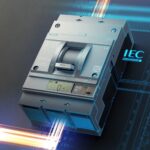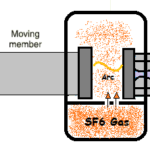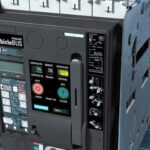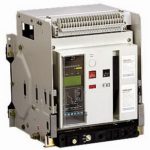A Type B MCB is a common type of miniature circuit breaker used to protect low power domestic circuits and residential application from overcurrent and short circuit faults.
The MCB trips the circuit and protects the equipment connected in that circuit from high fault current before getting damaged. Read Circuit Breaker Working.
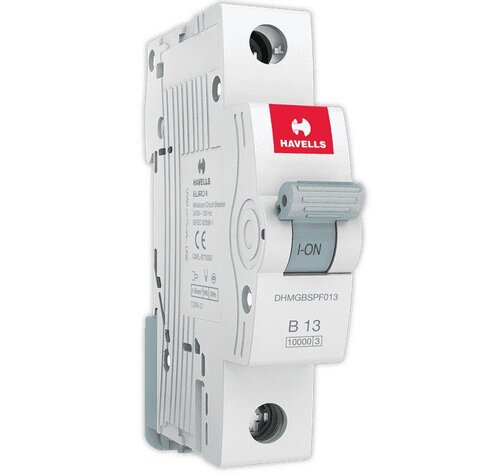
The tripping of different types of MCBs are in different ways. These tripping characteristics should be studied before selecting an MCB for an application. In this article I will explain about Type B MCB uses, trip curve, difference from type C MCB and many more things.
Miniature circuit breakers are classified to different types based on their tripping characteristics.
The main types of MCB are
- Type B MCB
- Type C MCB
- Type D MCB
- Type K MCB
- Type Z MCB
Among these, Type B MCB are mainly used for low power domestic applications like lighting circuits, home wirings etc.
Note: While selecting a type of MCB please ensure that the MCB does not give unwanted tripping when the device it is protecting is started up.
What is Type B MCB?
Type B Miniature circuit breaker is a common type of MCB used in residential applications and light commercial applications where connected loads are primarily lighting fixtures, domestic appliances with mainly resistive elements.
A type B MCB trips between 3 and 5 times its full load current.
Each of them have different tripping characteristics. Comparing their tripping characteristics they are selected for different applications.
As I mentioned above in a type B MCB the magnetic release operate between 3 and 5 times its full load rated current. That means it instantaneously trip when the current through the MCB is 3–5 times the rated current.
That means if you have 10A Type B MCB, it magnetically trips between 30A to 50A.
Where Type B MCB are Used?
This type of MCB is used for purely resistive loads that are non-inductive loads or with a very small inductive load which has no considerable amount of inductance.
This type of circuit breaker is used for purely resistive loads, or loads with a very small inductive component.
- Lighting circuits (non-inductive)
- General purpose outlets
B-curve MCBs have a magnetic (short circuit) trip level between 3 to 5 times their thermal (continuous) rating. These are most useful where you have a relatively low capacity (high impedance) supply, e.g. if you are “off grid” and getting your electricity from solar, wind, mini hydro or a small motor-alternator set, and your MCB rating is near to the rated capacity of your supply. However nuisance tripping may occur when starting appliances with high inrush loads, e.g. some plug packs and motors.
Reading Nameplate of MCB
Lets take an actual Type B MCB as an example. I will explain how to read the nameplate of the MCB.
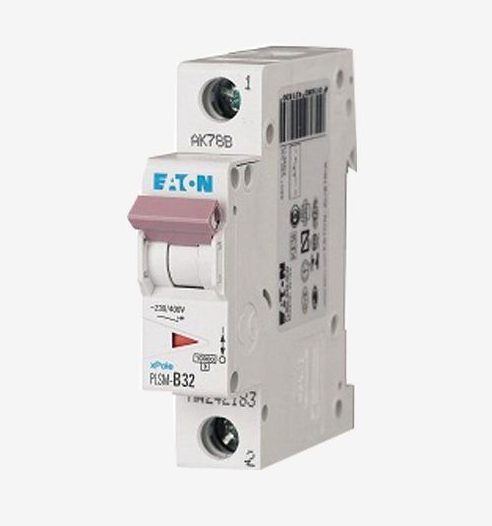
Now this is a PLSM-B32 MCB.
What does that means?
This MCB is PLSM series MCB.
It has tripping characteristics of TYPE B. It is instantaneously trip when the current through the MCB is 3–5 times the rated current. Otherwise, it takes time according to its trip characteristics graph.
Rated current of this MCB is 32A. So it instantaneously trip at current 96 – 160 A.
What is the difference between B and C Type MCB?
This is a common doubt that comes to the mind of every person while selecting an MCB for a normal application. Should I choose a B type MCB or a C type MCB. What is the difference between them?
I will try to explain the difference between Type B and Type C MCB in this section. Before that make sure to read the basics of miniature circuit breakers.
As I mentioned above, the importance of the “MCB types” is to ensure that the MCB does not give unwanted tripping when a device it is protecting is started up.
A type B MCB trips between 3 and 5 times full load current and a type C MCB trips between 5 and 10 times full load current. That means a Type B, 10A MCB trips at full load current between 30A and 50A.
Also a Type C, 10A MCB trips at full load current between 50A and 100A.
Circuit breakers with the “B” are normally used in residential installations (light and socket circuits).
For the “C” and “D”, these short-circuit currents are higher, so that loads with high inrush currents do not trips the circuit breaker every time they are switched on.
Imagine a carpenter with a large circular saw connected to a Type B MCB and the MCB trips everytime the saw is switched on. This is because of the large circular saw is load with high inrush current. So Type B circuit breaker cannot handle this. This requires a circuit breaker with a Type C or Type D characteristic.
Type C MCB are used for motor circuits (circular saws and smaller pumps), air conditioners and larger lamp groups.
|
Type B MCB |
Type C MCB |
| Type B MCB trips when full load current is between 3 and 5 times.
Example: A Type B10 MCB trips at full load current between 30A and 50A. This type of MCB is used for purely resistive loads It is used for load with a very small inductive component. They are mainly used in residential applications or light commercial applications. |
Type C MCB trips when full load current is between 5 and 10 times.
Example: A C10 MCB trips at full load current between 50A and 100A. This type of MCB is used for loads with a very high inductive component. This type of MCB is used in commercial or industrial types of applications where there could be chances of higher values of short circuit currents in the circuit. There are basically founds in industrial area (i.e. X-ray, Transformer, Motors etc.). |
Trip Curve of Type B Miniature Circuit Breakers
Type B MCB curve consists of two section – overload section and short circuit section. Overload section describes the trip time required for various levels of overload current. Short circuit section describes the instantaneous tip current level of MCB.
Type B curve is used for protection of the electrical circuits with equipment that do not cause heavy inrush/surge current (eg: lighting and distribution circuits).
There are three major components for the Type B Curve.
- Thermal Trip Curve : This is the trip curve for the bi-metallic strip. This is designed for slower overcurrents to allow for inrush/startup currents.
- Magnetic Trip Curve ; This is the trip curve for the coil or solenoid. It is designed to react quickly to large
overcurrents, such as a short circuit condition. - The Ideal Trip Curve. This curve shows what the desired trip curve for the bi-metallic strip is. Because of the organic nature of the bi-metallic strip, and changing ambient conditions, it is difficult to precisely predict the exact tripping point.
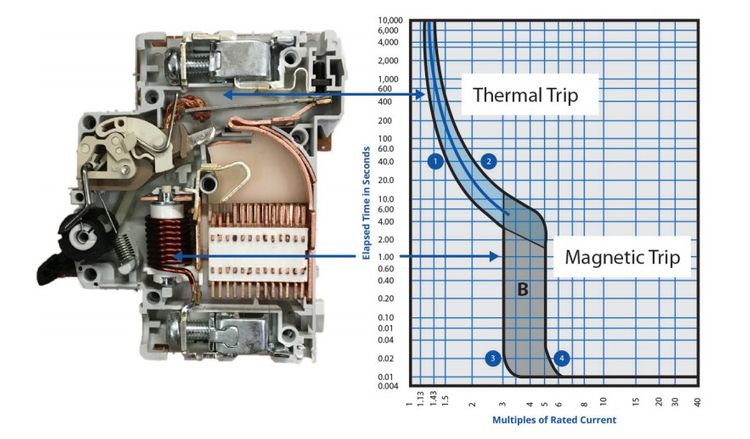
The top of the chart shows the thermal trip curve for the bi-metallic strip. It tells us that at 1.5X the rated current the quickest the circuit breaker will trip is forty seconds (1).
Forty seconds at 2X the rated current is the slowest the circuit breaker will trip (2).
The bottom of the chart is for the magnetic trip of the coil/solenoid; 0.02 to 2.5 seconds at 3X the rated current is the soonest the circuit breaker will trip (3).
The same duration, 0.02 to 2.5 seconds, at 5X the rated current, is the longest it will take the circuit breaker to trip (4).
The area shaded in between is the Tripping Zone.
